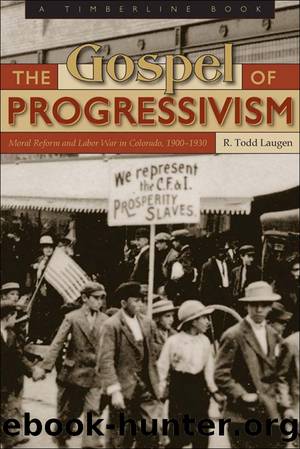The Gospel of Progressivism by R. Todd Laugen

Author:R. Todd Laugen [Laugen, R. Todd]
Language: eng
Format: epub
ISBN: 9781607320531
Barnesnoble:
Publisher: University Press of Colorado
Published: 2010-09-24T00:00:00+00:00
COLORADO WORKERS AND POSTWAR ELECTORAL POLITICS
The immediate postwar years saw workers nationwide experimenting with new electoral tactics. Colorado was no exception. Given union frustrations with the Industrial Commission in Colorado and the wartime Democratic Party, labor Progressives attempted to rally workers for a class-based challenge at the polls in 1920.78
The 1920 campaign initially revealed divisions over political tactics among labor leaders. Some AFL loyalists within the Colorado labor federation insisted that nonpartisan action was preferable to direct cooperation with the Democratic Party. Labor was partisan, insisted AFL president Samuel Gompers, to principles and not to any political party. Workers should campaign on behalf of the people against privilege. âThe trend of the times is distinctly non-partisan,â claimed Denver Labor Bulletin editor Ralph Moser. The splits within the state Democratic Party only reinforced the editorâs conviction that nonpartisan action was essential.79
Yet early support for nonpartisanship in Colorado gradually faded. The promise of a farmer-labor alliance was more appealing. The Non-Partisan League (NPL) of North Dakota appeared to show the way. Initially a group of North Dakota farmers, the NPL highlighted agrarian discontent with the Republican-dominated government in 1915. Tapping former Socialists to lead the revolt, the Non-Partisan League worked to capture the Republican Party in the 1916 and 1918 primaries. Although not technically creating its own party structure, the NPL gained control over North Dakota government and launched an ambitious experiment in state ownership of banking and distribution networks. Working with the Industrial Workers of the World, which had effectively organized harvest workers in the state, the NPL also initiated a labor program with broad appeal to workers.80
Attempting to expand its success after 1916, the NPL relocated its headquarters to St. Paul, Minnesota, in January 1917. There the NPL generated a great deal of support, especially among farmers. Yet the more heterogeneous economy in Minnesota made an NPL sweep of the state more difficult than in North Dakota with its one-crop, export-dependent economy. The Minnesota GOP launched an offensive to crush the NPL, drawing upon state government agencies during wartime to intimidate supporters and limit their access to public space. Still, NPL candidates made a strong showing in Minnesotaâs GOP primary of 1918. Organized labor in Minnesota allied with the NPL in August 1919, creating the Working Peopleâs Political League.81
NPL organizers from St. Paul appeared in Colorado in 1918, and the next year a number of union activists promoted a farmer-labor alliance for the 1920 election. Several leaders of the state labor federation worked to link NPL tactics with the nonpartisan program promoted by the AFLâs national leadership. In 1920 the AFL had launched a âradically new and important departure from its previous tactics,â according to one sympathetic observer. AFL unions could now focus energies on the primary elections in an effort to capture a major party, following the lead of the North Dakota NPL. This would mean a new application of the ârewarding friend, punishing enemiesâ policy, one that would wrest control of primaries from the party machines.82 While Colorado
Download
This site does not store any files on its server. We only index and link to content provided by other sites. Please contact the content providers to delete copyright contents if any and email us, we'll remove relevant links or contents immediately.
| United States |
In Cold Blood by Truman Capote(2702)
Steve Jobs by Walter Isaacson(2459)
All the President's Men by Carl Bernstein & Bob Woodward(1973)
Lonely Planet New York City by Lonely Planet(1857)
The Murder of Marilyn Monroe by Jay Margolis(1752)
The Room Where It Happened by John Bolton;(1729)
The Poisoner's Handbook by Deborah Blum(1672)
And the Band Played On by Randy Shilts(1632)
Lincoln by David Herbert Donald(1622)
The Innovators by Walter Isaacson(1612)
A Colony in a Nation by Chris Hayes(1531)
The Innovators: How a Group of Hackers, Geniuses, and Geeks Created the Digital Revolution by Walter Isaacson(1519)
Under the Banner of Heaven: A Story of Violent Faith by Jon Krakauer(1426)
The Unsettlers by Mark Sundeen(1347)
Amelia Earhart by Doris L. Rich(1346)
Birdmen by Lawrence Goldstone(1346)
Decision Points by George W. Bush(1261)
Dirt by Bill Buford(1247)
Zeitoun by Dave Eggers(1232)
